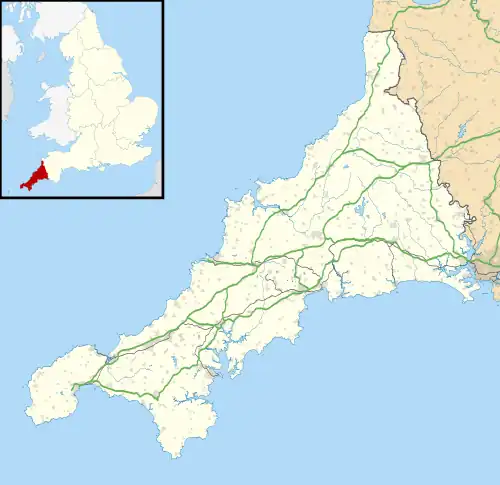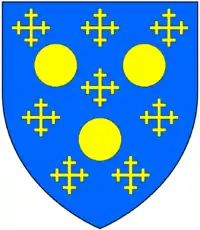Lawhitton
Lawhitton (Cornish: Nansgwydhenn) is a village in the civil parish of Lawhitton Rural, in east Cornwall, England, United Kingdom. The village is situated two miles (3 km) southwest of Launceston and half-a-mile west of Cornwall's border with Devon at the River Tamar.[1]
Lawhitton
| |
|---|---|
 A terrace of cottages in Lawhitton | |
 Lawhitton Location within Cornwall | |
| Population | 232 (Civil Parish, 2011) |
| OS grid reference | SX355824 |
| Civil parish |
|
| Unitary authority | |
| Ceremonial county | |
| Region | |
| Country | England |
| Sovereign state | United Kingdom |
| Post town | LAUNCESTON |
| Postcode district | PL15 |
| Dialling code | 01566 |
| Police | Devon and Cornwall |
| Fire | Cornwall |
| Ambulance | South Western |
| UK Parliament | |
Governance
The civil parish of Lawhitton was abolished in 1894 and the parishes of Lawhitton Urban and Lawhitton Rural were created. On 1 April 1922 Lawhitton Urban was abolished into Launceston parish.[2] In 1891 the civil parish of Lawhitton had a population of 361.[3] The parish of Lawhitton Rural is in the Launceston registration district. It is a comparatively small parish and Lawhitton village is the principal settlement. The border with Devon forms the parish's eastern boundary; to the north, it is bounded by St Thomas by Launceston parish; to the west by Launceston parish; and to the south by Lezant parish. The population of Lawhitton Rural in the 2001 census was 270,[4] decreasing to 232 at the 2011 census.[5]
History

At the time of Domesday Book (1086) the manor was held by the bishop and had 11 hides of land and land for 40 ploughs. The lord had land for 2 ploughs with 7 serfs, and 27 villeins and 20 smallholders had land for 29 ploughs. There was 8 acres of meadow, 100 acres of pasture and 10 acres of underwood. The value of the manor was £17 though it had formerly been worth only £8.[6]
Until 1261 the benefice of Lawhitton consisted of a vicarage and a sinecure rectory; they were then combined as a rectory. From then until 1924 there were 60 rectors, of whom probably only 19 were resident.[7] The last of these rectors was Henry Du Boulay who was concurrently Archdeacon of Bodmin from 1892 to 1924[8][9] Du Boulay was ordained in 1864 and died in 1925;[10] he was the son of an earlier rector of Lawhitton.
There is a Cornish cross at Treniffle; it was found built into an old barn at Tregada Farm about 1883 and then placed in her garden by Mrs. Morshead.[11]
Parish church

The parish church of St Michael is in Lawhitton village at SX 355 825; it is of various periods of English Gothic architecture. The plan is unusual and the tower stands in the position of a south transept. The tower is 13th century in date and there is a north aisle. The font is Norman, of the Altarnun type. Features of interest include the Jacobean pulpit, 1665, and two monuments, to R. Bennet (d. 1683) and in Coade stone to Richard Bennet-Coffin (d. 1796).[12]
Bennett-Coffin family

Richard Bennet (d.1619), a Councillor at Law, built Hexworthy House as his seat within the parish. The Bennet family originated in Sussex and settled at Hexworthy during the reign of Queen Elizabeth I (1558–1603).[14] His son was Col. Robert Bennet (1605–1683) of Hexworthy, a Member of Parliament during the Civil War and a noted commander of the Parliamentarian forces.[14] His descendant Richard Bennett-Coffin (d.1796) was the second son of Edward Bennett of Lawhitton by his wife Honor Coffin (born 1682), 11th daughter of Richard Coffin (1623–1700) of Portledge in the parish of Alwington in North Devon, lord of the manor of Alwington and Sheriff of Devon in 1683.[15] Richard Bennett-Coffin (1715-1796) became heir to the Coffin estates following the death of his childless uncle Richard Coffin (1684–1766). The Coffin family had been established at Alwington since the reign of King Henry II (1154–1189), and remained there in unbroken male succession until 1766.[16] Richard Bennett adopted the name and arms of Coffin in 1767 by Act of Parliament, but died without progeny at Esher in Surrey and was buried at Lawhitton where survives his monument.[17] However, the inscription on this is misleading in its ending: 'Dying without Issue In him ended the Lineal Descent of the Families of BENNETT and COFFIN'. Richard had an elder brother, William Bennett (1712-1788), who had many descendents (see his memorial stone in St Stephen by Saltash church, Saltash, Cornwall).
Richard's heir was Rev. John Pine-Coffin (1735–1824), eldest surviving grandson of Dorothy Coffin (1651–1690), eldest daughter of Richard Coffin (1623–1700), who in 1672 married Edward Pyne (1648–1675) of East Down. Her descendants remained seated at East Down manor house until 1866, the Pyne family having occupied it since the 13th century.[18] The last in the Pine-Coffin family to occupy Portledge manor house was Richard Geoffrey Pine-Coffin (1908–1974).
Famous inhabitant
James Ruse 1759–1837 from the area was aboard the first fleet of convicts into Sydney cove in 1788. He went on to become a celebrated farming pioneer.
References
- Ordnance Survey: Landranger map sheet 201 Plymouth & Launceston ISBN 978-0-319-23146-3
- "Launceston Registration District". UKBMD. Retrieved 9 March 2018.
- "Population Statistics Lawhitton CP/AP through time". Vision of Britain. Retrieved 3 March 2018.
- GENUKI website; Lawhitton page; retrieved April 2010
- "parish population 2011". Retrieved 10 February 2015.
- Thorn, C. et al., ed. (1979) Cornwall. Chichester: Phillimore; entry 2,9
- Cornish Church Guide (1925) Truro: Blackford; pp. 139–40
- Prussia Cove houses Archived 26 March 2012 at the Wayback Machine ("Cornwall" is a mistake here)
- "Cornwall Record Office; du Boulay". Cornwall Council. Retrieved 24 September 2011.
- Brown, H. M. (1976) A Century for Cornwall. Truro: Blackford; p. 89
- Langdon, A. G. (1896) Old Cornish Crosses. Truro: Joseph Pollard; p. 186
- Pevsner, N. (1970) Cornwall; 2nd ed., rev. by Enid Radcliffe. Penguin; p. 99
- Vivian, Lt.Col. J.L., (Ed.) The Visitations of the County of Devon: Comprising the Heralds' Visitations of 1531, 1564 & 1620, Exeter, 1895, p.208-11, pedigree of Coffin, p.208 arms given with 9 crosses crosslet. 8 as surviving monument of James Coffin (d.1566) in Monkleigh Church
- "Hexworthy House – Launceston Then!". Retrieved 16 December 2020.
- Vivian, Lt.Col. J. L., (Ed.) The Visitations of the County of Devon: Comprising the Heralds' Visitations of 1531, 1564 & 1620, Exeter, 1895, p.210, pedigree of Coffin
- Burke's Genealogical and Heraldic History of the Landed Gentry; 15th edition, ed. Pirie-Gordon, H., London, 1937, p.442, pedigree of "Pine-Coffin of Portledge". 1766, death of Richard Coffin
- Vivian, p. 210
- Pevsner, p.349